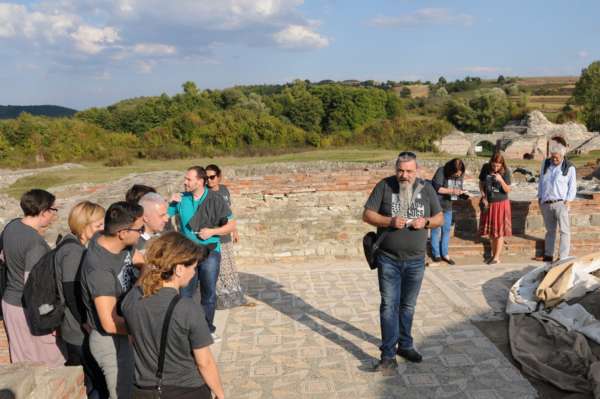
– by Maja Franković Branislava & Lazarević Tošović –
An international expert meeting SEE MOSAICS V: “Conservation of Mosaic Bedding Layers – How to Preserve” was held in Zajecar, from October 1-4, 2019.The meeting was implemented as the four-day event during which 41 participant from 12 countries worked on the issue of how to conserve mosaics on archaeological sites. Trough lectures and discussions, participants tackled questions concerning past and present solutions for conservation of mosaics on sites, in situ conservation-restoration techniques and the use of modern technologies and materials, as well as presentation challenges of mosaics conserved in situ (site management, monitoring and maintenance strategies). One working session was organized jointly with the participants of the Experts meeting: Interpreting and Presenting Cultural Heritage Sites: Mosaics in the Region (EUSAIR), as both experts meetings were realized as part of the programs during the Serbian Presidency of the EU Strategy for the Adriatic-Ionian Region (EUSAIR) and the Adriatic-Ionian Initiative.
Study visits were made to the National Museum “Zaječar” and National Museum in Leskovac, to archeological sites Felix Romuliana and Caričin Grad, monastery Bukovo and the contemporary mosaic by famous artist Mladen Srbinović comisioned in 1977 for the Gamzigrad Rehabilitation Center (Gamzigradska Banja).
The program of the meeting was concluded with a round table of the project team members and a final discussion. Following conclusions were made:
1. It has been once more confirmed that, in order to enable functional conservation of mosaics in situ, efficient implementation of a management plan is essential. Good management plan has to enable sustainable care for mosaics by means of regular monitoring and maintenance. The most common misconclusion is that sheltering of sites is the mean to enable presentation of mosaics. However, in practice, shelters often can create more problems, for preservation of mosaics as well as whole sites. On the other side, well thought out sheltering could be a method for presenting mosaics, but it shouldn’t be taken as the only and prevalent solution. It is paramount to understand conditions for the specific site and to identify present risks.
2. The question was raised if the visibility of mosaics is the only reason for visiting the sites and whether it is by all means necessary to enable their exposure. Presentation of mosaics does not require always exposing the actual mosaic. Alternative models of presentation could be successfully implemented, for example 3-D prints of mosaics to be placed on site or multimedia presentations. This question requires more debating and could be further explored on one of following SEE Mosaics meetings.
3. Modern techniques of documentation should be recognized as an excellent tool for recording various types of information that can be useful for different segments of cultural heritage protection. Creating database on GIS platform can be implemented to share information on mosaics on the regional level. It was suggested to start preparing pilot project with this subject.
4. It is necessary that experts involved in the study and protection of mosaics draw attention of decision makers about the fragility of mosaic heritage and its specific conservation needs. Great deal of relevant information could be provided by conservation professionals. In order to influence decision makers in the SEE region, engagement of the SEE Mosaics network as a group could be a way to draw attention to the issue. It is suggested to organize a meeting dedicated to discussing management issues of sites with mosaics, as well as to advocate for the specific needs of mosaic conservation at policy makers.
The insights and analysis presented in the SEE Mosaics Meeting V contributed to better understanding of the challenges in mosaic heritage preservation and explored ways and means how to make it more functional. SEE Mosaics Meeting V continued to foster the network of experts in the field of mosaic conservation and restoration. Networking of specialists contributed to strengthening international cooperation in conservation and presentation of mosaics in SE Europe and contributed to the greater cohesion of the cultural heritage sector in the region.

The event was organized by the Central Institute for Conservation in cooperation with the National Museum “Zaječar”, with the support of the Central European Initiative (CEI), Ministry of Culture and Information of the Republic of Serbia, AdriaticandIonianInitiative – AII, European Strategy for the Adriatic-Ionian Region (EUSAIR), The French Institute in Serbia and the Center for Cultural Heritage. The event is also supported by companies Koto, MAPEI Belgrade and Röfix.
